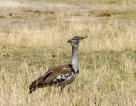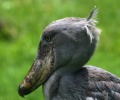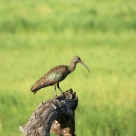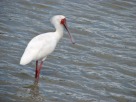TANZANIA TANZANIA WILDLIFE - BIRDS
Birds
Tanzania is a great ornithological destination. The national checklist of 1,100 bird species is the third-highest in Africa, representing more than 10% of the global avifauna, and a well-planned two-week itinerary is likely to result in a trip list of 300-plus species.
Popular savannah game reserves such as the Serengeti and Selous are no less rewarding for birds than for mammals, and make an ideal introduction to the more conspicuous and widespread species. For more experienced birders, the forested Eastern Arc Mountains are the country’s biggest attraction, since they harbour a high proportion of the 35-odd endemics whose range is limited to Tanzania.
Birding is good throughout the year, but the prime season is Sept-April, when resident populations are boosted by the many Palaearctic migrants that spend the northern hemisphere winter in Africa. The European winter also broadly coincides with East Africa’s rainy season, when several resident species undergo an ‘ugly duckling’ transformation from drab brown to bright breeding colours.
Large ground birds
Large waterbirds
Small waterbirds
Birds of prey
Other large birds
Medium sized birds
Medium-small birds
Smaller birds
Large ground birds
Ostrich - Secretary bird - Kori bustard - Ground hornbill - Francolins - Guineafowl
Ostrich - Secretary bird - Kori bustard - Ground hornbill - Francolins - Guineafowl
Ostrich - Hatching from an football-sized egg, the handsome male of the world’s largest bird is black and white, whereas the dowdy female is scruffy grey-brown. The domestic ostrich is a source of low-fat meat in South Africa, but isn’t farmed much in East Africa. A flightless resident of open savannah, it is common in the southeast Serengeti, but occurs in suitable habitats elsewhere in Tanzania.
Secretary bird - This name of this bizarre 1.5m tall grassland raptor could allude to its quill-like crest, but more likely derives from the Arabic saqr-et-tair (hunting bird). A terrestrial hunter, it feeds mainly on snakes, stamping them to death in a comical flailing dance. It roosts in trees, and will take off when disturbed, requiring a run up reminiscent of an aeroplane on a runway. It is widespread in Tanzania but particularly common in the southern Serengeti.
Kori bustard – The world’s heaviest flying bird, this sturdy grassland species has brown wings, speckled white belly, prominent backward crest, and a rather ponderous gait. A reluctant but strong flyer, it’s very common in the Serengeti and Ngorongoro but absent further south and west.
Ground hornbill - One of Tanzania’s most striking birds, this black turkey lookalike has white underwings, red wattled throat and eyes, and flamboyant fluttering eyelashes. Typically seen marching through light woodland in small parties, it has a heavy casqued bill, used to secure live prey ranging from small insects to large rodents.
Francolins – The African equivalent to pheasants and chickens, these plump game-birds are all but ubiquitous, and the dozen species recorded in Tanzania are as noisy as their domestic counterparts. Two species are endemic: the conspicuous grey-breasted francolin of the Serengeti and the Udzungwa forest partridge, first discovered in the eponymous mountains in 1991.
Guineafowl – The helmeted guineafowl is a widespread, common and somewhat panicky white-speckled grey bird with a blue head and ivory casque. The similar crested guineafowl is a localised forest resident with unruly black head feathers, while the stunning vulturine guinea-fowl, whose Tanzanian range is restricted to Mkomazi, has a cobalt chest covered in lacy black-and-white feathers.
Large waterbirds
Pelicans - Flamingos - Herons & egrets - Storks - Ibises & spoonbills - Crowned crane
Pelicans – The larder-billed great white pelican is a massive white bird with black underwings and a large yellow pouch. The smaller pink-backed pelican has a light grey back and dark flight feathers. Synchronised flotillas of either species might be seen bobbing on larger lakes, particularly Manyara, and around Rubondo Island.
Flamingos - The algae-sifting greater and lesser flamingos rank among East Africa’s most popular avian attractions, with an estimated 5-6 million present birds present. They breed on the inaccessible north of Lake Natron, but large flocks are frequent in Manyara, Arusha NP and Ngorongoro Crater.
Herons & egrets – This conspicuous family of long-legged birds is represented by 20 species, including the familiar grey heron, the truly spectacular goliath heron and various white or black egrets. Most species are water dependent, with the Rufiji River in Selous being good for varied sightings. The black-blacked heron often forages in grassland and cultivation, while the ubiquitous cattle egret flocks around buffalo herds to catch disturbed insects.
Storks –Tanzania’s eight stork species include three migrants, notably the familiar Eurasian variety. Of the resident species, the ubiquitous marabou is a fabulously ugly omnivore with scabrous scalp, fleshy neck pouch and the demeanour of a Victorian undertaker. The Serengeti is a stronghold for the saddle-billed stork, a handsome pied giant with a red and yellow bill, while Selous and Ngorongoro are good for the yellow-billed stork, which resembles its Eurasian counterpart but has a yellow bill.
Ibises & spoonbills – Ibises are robust birds with decurved bills designed to probe soil for molluscs. Most visible and audible is the hadeda, whose onomatopoeic cackle is characteristic of suburban hotel gardens. Also common, the sacred ibis was revered in ancient Egypt, while the related African spoonbill wades through shallow water sweeping its unique spatulate bill from side to side.
Crowned crane – Associated with marsh and rank grassland, this astonishing bird has grey feathering capped by a bristly gold crown and red neck wattle. It is common in suitable habitats in the Serengeti and Ngorongoro; listen out for its booming nasal call.
Small waterbirds
Hamerkop - Cormorants & darters - African skimmer - Waterfowl - Waders and plovers - African jacana
Hamerkop – Placed in its own family, this rusty-brown frog-eater has a flattened bill and angular crest, creating the hammer-like appearance alluded to in its Afrikaans name ‘hammer head’. A widespread inhabitant of wooded freshwater habitats, it constructs a massive and untidy nest using branches, sticks, mud and anything else that comes to hand, usually in a tree fork close to the water.
Cormorants & darters – Skilled fishers distinguished by disproportionately long necks, cormorants are represented by two species, both common in the vicinity of water. The equally widespread but more beautiful African darter has a kinked serpentine neck as long as its torso.
African skimmer – This eagerly sought tern lookalike feeds by flying low above the water, with the extended lower mandible of its bright red bill slicing the surface. Its favoured habitat is wide rivers fringed by permanent sandbanks, notably the Rufiji in Selous.
Waterfowl – About 20 species of ducks and geese are recorded, many as seasonal migrants. The conspicuous Egyptian goose is a large rufous-brown waterfowl known for its assertiveness and loud honk. Larger still is the spur-winged goose, weighing in at 8-10kg. Also common are the white-faced whistling-duck, knob-billed duck and yellow-billed duck, all of whose most obvious field characters are reflected in their names. Arusha and Ngorongoro during the rainy season support high waterfowl concentrations.
Waders and plovers – Waders are a diverse family of small shorebirds. At least 30 species are known from Tanzania, many as vagrants, and most are quite difficult to identify. The superficially similar plovers, represented by almost 20 species, are generally less water dependent and more distinctly patterned. The most striking shorebirds are the black-winged stilt and pied avocet, both of which are quite common. Shorebird enthusiasts are pointed to Rift Valley lake such as Manyara, Natron and Eyasi.
African jacana – Also known as the lily-trotter, this handsome has a rich chestnut torso, white neck, black cap, and blue bill and frontal shield, but is most notable for its wide-spreading toes, which allow it to walk on lilies and other floating vegetation. It is common on marshy or well-vegetated pools and river edges throughout Tanzania.
Birds of prey
Tanzania is home to 75 species of raptor, with the likes of Serengeti, Manyara, Selous and Ruaha each having checklists of 50-plus. Some of the more charismatic and common species are as follows:
Verreoux's eagle - Fish eagle - Bateleur - Auger buzzard - Vultures - Kites
Verreoux's eagle - Fish eagle - Bateleur - Auger buzzard - Vultures - Kites
Verreaux's eagle - Africa’s second-largest raptor is Verreaux’s eagle, whose black feathering is offset by yellow beak and legs, and a distinctive white ‘V’ on its back. Associated with cliffs (Serengeti’s Lobo Hills are a good site), it feeds mainly on hyraxes and has a stunning courtship display, falling hundreds of metres in one swoop.
Fish eagle - No other sound evokes Africa like the piercing cry of the fish eagle, a black-and-white piscivore with a chestnut belly and yellow bill. Monogamous pairs perch in waterside trees throughout Tanzania, but it’s particularly common along the Rufiji River in Selous, as is the palmnut vulture, which looks similar (but has a red mask) and feeds mainly on the fruit of raffia palms.
Bateleur - the bateleur is a heavyset black eagle named for its unique flight pattern, which recalls the wobbling of a tightrope walker. The red mask, beak and legs render it unmistakable, and its stunted orange tail and tilting motion are distinctive in flight. It could be seen in any savannah habitat, as might the massive martial eagle, which has a black back and speckled breast, and the uniform buff-brown tawny eagle and dark-brown steppe eagle.
Auger buzzard - The auger buzzard is a handsome pied raptor whose orange tail precludes confusion with anything but the bateleur. It is often seen soaring or perching openly in moist highlands (e.g. Ngorongoro, Kilimanjaro, Arusha), as is the dark-brown long-crested eagle, whose foppishly windblown occipital crest and distinctive white wing bars (seen in flight) are unmistakable.
Vultures - A flock of vultures squabbling around a carcass might lack for dignity, but these scavengers perform a vital ecological role as ‘garbage men’. The white-backed vulture often comprises 90% of the headcount, while the ghoulish appearance of Africa’s largest raptor, the lappet-faced vulture,is reinforced by its custom of spreading its black wings open like a cape. Circling vultures may sometimes indicate the location of a kill, but they might also be exploiting a particularly good thermal!
Kites - Frequently seen in urban area, the black kite is Tanzania’s commonest raptor, and a bold scavenger, as routinely witnessed by picnickers in the Ngorongoro Crater. The smaller and plumper black-shouldered kite is often seen hovering spectacularly along the roadside.
Other large birds
Crows - Hornbills - Owls - Turacos & go-away birds - White-browed coucal - Lilac-breasted roller
Crows – Adaptable feeders, crows are perhaps the most intelligent of birds, capable of using tools and often becoming aggressive scavengers at campsites. Common species include the white-necked raven, Africa’s second largest passerine, and the marginally smaller pied crow and fan-tailed raven, all of which spend much of their time on the wing, when they could be mistaken for raptors.
Hornbills – These characterful birds inhabit every habitat from desert to jungle, and are recognisable by their heavy decurved bills. They nest in tree cavities: the incubating female seals herself in by plastering the entrance closed, and the male feeds her through a slit until the eggs hatch and she breaks the seal. The ground-feeding omnivores of the genus Tockus includes firm safari favourites such as red-billed and grey hornbill, while the bulkier frugivores of Bycanistes are conspicuous forest birds with raucous nasal calls and heavy wing beats.
Owls - Feared locally as harbingers of death, Tanzania’s 15 owl species range from the thrush-sized African scops-owl, which flattens its bark-coloured body to look like a tree trunk, to the immense Verreaux’s eagle-owl. These – and other widespread species such the spotted eagle-, barn and pearl-spotted owl – might be chanced upon almost anywhere, but it requires dedication to locate the endemic Usambara eagle-owl (Eastern Arc Mountains) or Pemba scops-owl (Pemba Island).
Turacos & go-away birds – Unique to Africa, turacos are colourful crested frugivores that draw attention to their presence with far-reaching guttural calls. The spectacular green-and-red Hartlaub’s turaco inhabits montane forest on Kilimanjaro and Ngorongoro, while Schalow’s turaco occurs in lower-lying Saadani and Udzungwa. Ross’s turaco is sometimes seen along the Serengeti’s Grumeti River, while the comparatively drab go-away birds are associated with wooded savannah habitats.
White-browed coucal – This clumsy-looking denizen of rank grassland and water margins is known locally as the rainbird, since its attractive dove-like bubbling call often predicts stormy weather.
Lilac-breasted roller – Common in savannah habitats from the Serengeti to Selous, this jay-like safari favourite has a lilac chest, sky-blue underparts and golden-brown back. Perching openly on a branch, it can be a cooperative photographic subject.
Medium sized birds
Superb starling - Red-billed and yellow-billed oxpeckers - Common bulbul - Fork-tailed drongo - Black-headed oriole - Paradise flycatcher
Thrushes - Wagtails - Babblers - Shrikes - Boubous & bush-shrikes - Bishops & Widows
Superb starling – Popular with first-time safarigoers, the most spectacular of the region’s ‘glossy starlings’ has glossy blue upperparts separated from the red belly by a white band. Locally abundant in the Serengeti, Manyara, Tarangire and Ngorongoro, it is rare or absent in the south and west.
Red-billed and yellow-billed oxpeckers - Closely related to starlings, these otherwise nondescript birds spend much of their time picking ticks of buffaloes, antelope, giraffe and domestic cattle. They are now quite rare outside of game reserves.
Common bulbul – Encountered by most visitors to Tanzania, this cheerful extrovert is a versatile garden and forest-edge bird with an upright stance, crested head and trademark yellow vent. By contrast, the related greenbuls and brownbuls, represented by at least 35 East African species, tend to be secretive, cryptically marked and difficult to identify.
Fork-tailed drongo – This pugnacious all-black bird has a deep forked tail and is common in wooded savannah, where it perches openly and often emits a series of harsh, nasal notes. It could be confused with the slighter black flycatcher.
Black-headed oriole – This is a common woodland bird with brilliant yellow feathers, black head, red bill and an attractive liquid call. The rarer green-headed oriole is an eagerly sought montane forest bird that’s most easily seen in Udzungwa or Amani.
Paradise flycatcher – This popular resident of woodland and forest is notable for the male’s extended tail, which is twice the body length. It is usually bright orange with a blue-black head and chest, but the black-and-white morph is locally common, and intermediate forms also exist.
Thrushes – This diverse family, represented by about 50 species, includes such prominent garden birds as thrushes (which resemble their European counterparts) and the beautiful robin-chats. It also includes the open country wheatears and chats, and the boldly marked mocking chat, which is associated with koppies such as those in the Serengeti.
Wagtails – The African pied wagtail is one of Tanzania’s most familiar birds, often seen alongside hotel swimming pools with its elongated tail bobbing up and down. In some areas, it is outnumbered during the northern winter by the migrant yellow wagtail, seven distinct races of which are recognised.
Babblers – These robust thrush-sized birds habitually travel through the undergrowth in noisy parties of 5-10 individuals, and are often seen in hotel grounds. The most colourful species is the rufous chatterer, an orange-brown bird associated with dry country parks such as Tarangire and Mkomazi.
Shrikes – Sometimes referred as butcher birds in reference to their custom of impaling their prey on thorns, shrikes are boldly patterned insectivores that perch conspicuously on the top of shrubs and trees. The widespread common fiscal is usually seen singly or in pairs, but the more gregarious grey-backed fiscal and magpie shrike are also common in the Serengeti.
Boubous & bush-shrikes – Endemic to Africa, this family of striking but furtive birds is more often heard than seem. The common tropical boubou is also known as the bellbird in reference to its synchronised ‘ring… chirr’ duet, while the colourful grey-headed bush-shrike is sometimes called the ghostbird, since it habitually sits motionless in the high canopy repeating its drawn out-hollow whistle.
Bishops & Widows – Closely allied to the weavers, these boldly patterned birds are associated with marshes, moist grassland and reedbeds. Most striking is the long-tailed widow, whose long, drooping tail gives it a total length of 75-80cm during the breeding season. It is run a close second by the brilliant red bishops, which breed communally in reedbeds, and the golden bishop, which puffs up to look an oversized bumblebee to attract a mate.
Medium-small birds
Parrots & lovebirds - Doves - Cuckoos - Mousebirds - Trogons - Hoopoes
Kingfishers - Bee-eaters - Woodpeckers - Barbets - Honeyguides - Swifts & swallows
Parrots & lovebirds – Parrots are poorly represented in Tanzania, and can be elusive, tending to emit a series of explosive screeches before they flap out of view with characteristically direct flight. The smaller lovebirds are sociable and brightly coloured savannah-dwellers with distinctive parakeet-like bills. Yellow-collared and Fischer’s lovebirds are both naturally endemic to northern Tanzania, with the former most likely to be seen in Tarangire and the latter in Serengeti.
Doves – These familiar plump birds are ubiquitous, and the calls of the ring-necked and red-eyed doves (respectively transcribed as ‘work harder, work harder’ and ‘I am a red-eyed dove’) rank among the definitive sounds of the African bush, as does the soft descending coo of the laughing dove and emerald-spotted wood-dove. The Pemba green pigeon is endemic to Pemba Island.
Cuckoos – Highly vocal but equally ventriloqual, most cuckoos are unlikely to be seen unless actively sought. The clamorous dee-dee-dee-Diederik of the Diederik cuckoo (often heard near the weaver colonies it parasitises) and persistent it-will-rain of the red-chested cuckoo are among the most familiar sounds of the African bush. Legendarily elusive, the emerald cuckoo is a forest species whose triumphal YOU-can’t-find-me drives birdwatchers to distraction as they scan the canopy in vain.
Mousebirds - Endemic to Africa, these long-tailed and prominently crested frugivores are named for the mouse-like manner in which they shuffle along branches. They are generally seen in flocks of around 5-8 birds, flying laboriously between fruiting trees.
Trogons – Among the most eagerly sought of African birds thanks to their lustrous green back and contrasting crimson breast, trogons spend much of their time sitting motionless in forest interiors and are best located by call. The eagerly sought Narina trogon might be seen in any low-altitude riparian woodland or forest, while the localised bar-tailed trogon is sometimes observed in montane forests on Ngorongoro.
Hoopoes - Common in park-like savannah and suburban hotel gardens, the African hoopoe is a distinctive orange ground bird with a curved bill, prominent crest, and black and white wings. Closely related but very different in appearance, woodhoopoes are gregarious glossy-black woodland birds with long tails, heavy decurved red or black bills, often located by their cacophonous cackle.
Kingfishers – Tanzania’s dozen species are a variable bunch. The most widespread fish-eater is the pied kingfisher, which often hovers hummingbird-like above the water. The 50cm giant kingfisher is associated with tree-lined rivers and lakes, while the tiny malachite kingfisher perches low on waterside reeds and shrubs. The Halcyon kingfishers are insectivores and typically inhabit wooded areas, often some distance from water.
Bee-eaters - These sleek, colourful and sociable insectivores are well represented in Tanzania, with more than half the world’s 25 species present. Unusually, they can eat stinging insects, which they disarm by banging or scraping them against a branch with their long decurved bill. The ubiquitous little bee-eater might be seen anywhere, but most other species are relatively localised.
Woodpeckers - Inconspicuous when feeding, woodpeckers often announce their presence by drumming loudly on a dead branch or emitting a harsh nasal call. Most of the region’s species have dark green upperparts and pale underparts, and can be identified by taking precise note of the head markings and whether the belly is streaked, striped, spotted or barred.
Barbets – Stocky and colourful, barbets occur in every habitat from desert to rainforest. Most likely to be seen on safari is the red-and-yellow barbet, a strikingly coloured bird that performs a clockwork-like duet on termite mounds in dry-country parks such as Tarangire. The southern equivalent is the crested barbet, whose unique high pitched trill is characteristic of Ruaha. The red-faced barbet is a regional endemic restricted to moist savannah west of Lake Victoria.
Honeyguides – The most visible member of this inconspicuous family is the greater honeyguide, which is also the only species to perform the eponymous trick of guiding people (and honey-badgers) to beehives, where it feed on discarded scraps of honeycomb.
Swifts & swallows – The most aerially specialised of birds, the swifts can feed, mate and even sleep on the wing, and roost on vertical surfaces only. Most species are dully coloured and mixed flocks are often seen circling rapidly in the vicinity of cliffs, bridges and tall buildings. Similar in design and habits but more colourful, the unrelated swallows are typically blue with white, red or streaked underparts – several species are resident but most are outnumbered by the influx of European barn swallows during the northern winter.
Smaller birds
Warblers - White-eyes - Weavers - Sunbirds - Waxbills & whydahs - Canaries
Warblers – Almost 10% of Tanzania’s bird species belong to this family of small inconspicuous LBJs (‘little brown jobs’). This includes the most confusing of African bird genera, Cisticola, as well as the boldly marked, long-tailed leaf gleaners of the genus Apalis, and the almost tailless crombecs of the genus Sylvietta.
White-eyes – These confiding warbler-like birds are among the most common garden residents in Tanzania, often seen moving through the foliage in parties of 5-10 individuals, their soft green-yellow plumage offset by a bold white eye-ring.
Weavers – A quintessential part of the African landscape, the sparrow-like weavers are named for the intricate ball-shaped nests built by the dextrous males. The various species of masked weaver are yellow with a distinct black facial mask, and often nest colonially in trees overhanging later. The finest nest in the family is the dome-like construction of the grosbeak weaver, which breeds in reedbeds. By contrast, the drab sparrow- and buffalo-weavers build scruffy nests, and include the rufous-tailed weaver, a Tanzania endemic whose range centres on Ngorongoro and the Serengeti.
Sunbirds – The Old World equivalent to the evolutionarily distant hummingbirds, sunbirds are small, restless, brightly coloured nectar-eaters with distinctive long decurved bills. About a third of the world’s 120 species occur in Tanzania, and most are highly sexually dimorphic, with the iridescent males typically being larger than the drab females. Positive identification of some species can be a slow and frustrating process, since many sunbirds look very similar and they seldom sit still for long.
Waxbills & whydahs – The waxbills are colourful but unobtrusive seedeaters with stout, conical bills. Most likely to be seen on safari are the purple grenadier, red-cheeked cordon-bleu, green-winged pytilia and red-billed firefinch, the latter often associated with human habitations. Whydahs are closely related to waxbills, which they brood parasitise, and are notable for their long tails. The pin-tailed wydah is common in the Ngorongoro highlands, while the spectacular paradise whydah inhabits drier bush country.
Canaries – Also known as seedeaters or serins, East Africa’s canaries are mostly unobtrusive, with busy but unmemorable songs, and several are quite dull coloured. Most common is the pretty yellow-fronted canary, though this is replaced by the similar white-bellied canary in drier parts of the interior.




















































